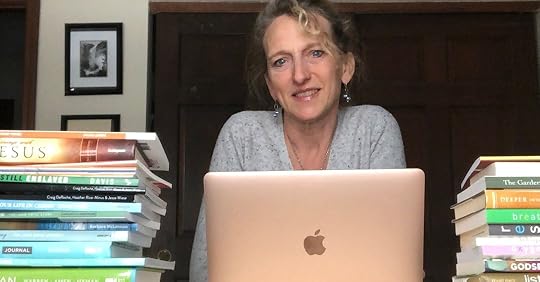Keri Wyatt Kent's Blog, page 5
October 25, 2022
Fall: perfect time to order your Advent devotional

I hope you’re enjoying fall as much as I am–I love this time of year! Be sure to get outside and revel in the beauty. But just a quick reminder: Christmas is two months from today!

Which means that Advent begins in about a month.
Let’s decide right now to not panic about the coming holidays, but to be intentional about enjoying every moment of the next 60 days. To prepare without panic, to be fully present in each moment. To focus on Hope, Peace, Love and Joy.
Here’s something to help you do just that: The Gift of Christmas Present, an advent devotional.
And guess what: it’s on sale this week for just $4.99 (40 percent off!). Some of you downloaded the free ebook version last year. It’s been updated for 2022, and you can order now in plenty of time to get one for yourself, and one for a friend or two! But this special price only lasts this week. After November 1, the price goes back to $8.
 Each day during the four weeks of Advent, you’ll read a verse and brief reflection, respond to a journaling prompt, and close in prayer. Five or ten minutes to start your day and remind you to be fully present each day during the four weeks leading up to Christmas.
Each day during the four weeks of Advent, you’ll read a verse and brief reflection, respond to a journaling prompt, and close in prayer. Five or ten minutes to start your day and remind you to be fully present each day during the four weeks leading up to Christmas.
Last year’s edition got all five star reviews on Amazon. Here’s what one reviewer said:
“This devotional study is beautifully written, reminding us the importance of slowing down in order to be truly and intentionally present during this busy season! We have been using this book for our church’s community Advent devotional as it is grounded in scripture, demonstrating how God’s word is our peace and his love, shown through Christ, is our greatest gift.”
Every entry has a journaling page–what a great way to capture your holiday season prayers and memories. Be sure to order today to save 40 percent!
The post Fall: perfect time to order your Advent devotional appeared first on Keri Wyatt Kent.
October 9, 2022
Feeling spiritually burned out? How to get get more out of reading the Bible

“Are you tired? Worn out? Burned out on religion? Come to me. Get away with me and you’ll recover your life. I’ll show you how to take a real rest. Walk with me and work with me—watch how I do it. Learn the unforced rhythms of grace.”

Photo by MART PRODUCTION from pexels.com
Do Jesus’ words resonate with you? Are you feeling worn out? Spiritual burnout is a thing, and it often happens when we’re doing too much, too fast. Our hustle and hectic can bleed over into our faith life, making it feel dry.
When that happens, we miss out. Jesus invites us to rest, to move in the unforced rhythms of grace. To walk with him. We do that by immersing ourselves in his story, and finding our own story within it.
Two Practices to Heal Spiritual BurnoutTwo practices can help us to get more out of reading the Bible: slowing down, and digging deeper.
I write a lot about meditating on Scripture, listening to the text. But here’s the truth: we can reflect and meditate and listen to Scripture all day, but if we haven’t built on a foundation of clear understanding, we’re going to be confused and maybe even misunderstand.
Once we’ve laid a foundation with knowledge we get from digging deeper–finding out, for example, what the cultural context of a certain letter was, or the meaning of various words in the text that might be slightly different from their English translation, we can slow down enough to let God speak through the word to us.
The foundation for meditation on Scripture is understanding Scripture. It can speak to our weary souls, if we slow down, and dig deep. Learn, study and then meditate on the truth that will set you free, that will allow you to live freely and lightly.
So: true confession, I don’t read my Bible every day. I love Scripture, which might seem weird, but I do. But I tend to read it, then spend a few days (or longer) sort of mulling over what I’ve read, thinking about it, meditating on it. I chew on each passage for a while, going back to it several times during a week.
For example, I’ve been camped out lately in the first half of Matthew 8, which tells about healings: of a leper, a centurion’s slave, and Peter’s mother-in-law, of an anonymous crowd of infirm people (and later in the chapter, two demon possessed men).
The leper asks if Jesus is willing, and Jesus not only replies that he is, but reaches out and touches the leper, a man who in that society was untouchable. The word translated “touch” means to embrace, to clasp. Our Sunday School images of Jesus sort of poking people to heal them are off, at least in this case. Jesus hugged someone who, because of his disease, hadn’t felt human touch in who knows how long. Reading on, we realize that Jesus was fully capable of healing without touching, but he knew this man needed the emotional healing that comes from being embraced when he’d been denied that for so long.
(Here’s how the Visual Bible renders it, which I think it pretty accurate and fun. By the way, watching a video of a Bible story is one way to meditate on God’s word.)
Reading on, the centurion demonstrates faith that Jesus finds remarkable. He asks Jesus to heal not with a poke or a hug, but with a word, from a distance. If you are willing, just say the word, Jesus, says this man who is not a part of a religion at all, and I believe that’s all that’s needed. And Jesus again says he’s willing, not just to heal but even to go to the centurion’s house–which by the way, most Jewish rabbis would not do, because the centurion was a Roman, a Gentile, an enemy. Jesus’ willingness is again remarkable.
Peter’s mother-in-law doesn’t even ask for Jesus’ help. She’s sick in bed with a fever, and the text says that “Jesus saw” her. He noticed. He healed not with an embrace or a word, but by touching her hand. He holds her hand, and you next thing you know, she’s up and making matzo soup in the kitchen. There’s no mention even of a conversation between the two of them–although I want to believe that it simply wasn’t recorded. Jesus was so willing to heal her that she didn’t even have to ask. There’s an intimacy in it.
The chapter goes on to talk about people coming by and bringing their sick and demon-possessed, and Jesus continues to heal and touch and restore.
I spend some time digging deeper, looking up keywords, reading some background. If I’m feeling super bible nerdy, I’ll dig through a commentary. One I love is the IVP Women’s Bible Commentary, which offers an egalitarian perspective.
Then, I take some time to slow down, to meditate on the text. That can be as simple as asking the questions that require a bit of time and reflection: where do I need healing in my life? Where is there pain or brokenness? What aches?
And do I believe Jesus is willing to heal. Not as in “oh, alright, if you can’t fix yourself I’ll do it.” Not that kind of healing. Which I confess, I tend to sometimes put on him. I project my own impatience with myself and my weaknesses, and assume Jesus is rolling his eyes at me. But Jesus, the text keeps saying, and showing, is willing. Joyfully willing. There’s a run up and hug, an “I can’t wait to do this for you,” kind of feel to Jesus’ willingness.
The phrase “I am willing” becomes Jesus’ word to me as I bring him some long-ignored broken bits, as I uncover some wounds I’ve ignored.
The realization that Jesus is so enthusiastically willing brought a moment of intimacy, not just as I read, but as I reflected on the passage over several days. He wants to restore, to bring wholeness, to replace pain with joy. I’m reminded again that listening to me, and even healing what’s broken, is something Jesus is wildly willing to do. He’s eager to engage.
It may seem paradoxical, but building the strong foundation of study is what brings life to our reflections. For example, the only way I can know that the word for “touch” in Matthew 8 means to clasp or embrace is because I used some Bible study tools to discover that. Understanding the text with our minds will allow truth to touch our hearts–and eventually, to transform them.
Want more?
Here’s another article that offers a bit more detail on how to study.
[image error]
Looking for a resource that can help you go deeper into Scripture? Check out my book 99 Bible Words You Should Know.
[image error]
The post Feeling spiritually burned out? How to get get more out of reading the Bible appeared first on Keri Wyatt Kent.
March 30, 2022
How do I let go of fear?

Our Lenten series on Deeply Loved continues. If you’d like to connect more frequently, click to follow me on Instagram or Facebook, where I am posting videos and other encouraging content about five days a week. We are currently on Day 28 of our 40 day journey!
Trust
Photo by Alex Green: from www.pexels.com
Today, we’re talking about trust. I’m currently working on my next book, which is about living courageously. When fear drives the bus, we are not heading toward trust. While fear is inevitable, allowing it to control you is not. We all have worries and fears–but we can choose how we respond to those concerns.
Even in a deeply divided society, we have this in common: we’re worried.About the future, about the past, even about the people on the other side of the divide.
Jesus asked, “Can any one of you, by worrying, add a single hour to your life?”
The path to letting go of fear and holding on to trust begins with gratitude. The bible says, “Do not be anxious about anything, but in every situation, by prayer and petition, with thanksgiving, present your requests to God. And the peace of God, which transcends all understanding, will guard your hearts and minds in Christ Jesus.” (Phil. 4:6-7)
Gratitude
That little word, thanksgiving. Gratitude. Gratitude ushers us into a place where trust is not contrived but genuinely experienced. We don’t have to strive to trust–it’s a gift, a grace. We get to trust by letting go of fear and practicing gratitude.
What are you grateful for today?

Photo by Alexandr Podvalny from www.pexels.com
Sometimes relationships are the reason we worry. But other times, relationships are the safe haven from our worry–the good thing in our life.
Who are you grateful for today?
Sometimes our finances cause us worry. But if you have enough to eat, you sleep in a warm bed, you’re able to get where you wanted to go today–those are good things in your life.
What are you grateful for today?
Trust flows out of our gratitude, as we pay attention to truth: God has brought you safe thus far. God will not abandon you. You are deeply loved.
PracticeToday, make a list of things you’re worried about. Set it aside, then make a list of things you’re grateful for. Give both lists to God, trusting God with the worries, and thanking God for the blessings.
For more frequent updates on our Deeply Loved journey, follow Keri on Instagram at www.instagram.com/keriwyattkent or Facebook at https://www.facebook.com/keriwyattkent
Want to join us as we read through Deeply Loved? Get a copy here.
The post How do I let go of fear? appeared first on Keri Wyatt Kent.
March 11, 2022
An invitation to spend time with God
 Welcome to Day 9 of our Deeply Loved Lenten journey.
Welcome to Day 9 of our Deeply Loved Lenten journey.
(By the way, if you’d like more frequent updates on this journey, follow me on Instagram or Facebook where I’m posting video devotionals every weekday.)
We live in a noisy, hectic world. Wouldn’t it be great to push pause, to step away for just a few moments? Today’s Deeply Loved practice is counter-cultural—but one that has been essential in the spiritual formation of Christians for centuries.
Today, you’re invited to spend time alone with God. You have the opportunity, if you’re willing to seize it, to put away distractions (including your phone!), in order to connect with the one who loves you best.
It’s not complicated. Find a place away from others (okay, that might be complicated, but you can do it!). Bring just your Bible and a journal. Then: Breathe. Listen. Simply be with God, without an agenda or to-do list or demands. Your goal is simply to settled down, get quiet, and enjoy God.
The surprising cure for lonelinessWe think our phones and other communication keep us connected. If that’s true, why do we sometimes feel so lonely? The cure for loneliness, surprisingly, is solitude.
Solitude is more than just being alone. Rather, this life-giving practice invites us to be alone with God.

Photo by Aaron Burden from StockSnap
Solitude, and its companion, silence, provide us a path to intimacy. The belonging and love we long for is found in these spiritual practices that simply ask us to let go, settle down, be quiet and alone.
Solitude can be challenging if you’re not used to it. But the more you engage in it, the more you begin to relax into it, to enjoy the freedom that disconnecting from the distractions brings.
You’re invited to playSolitude and silence are interconnected practices. So today and tomorrow, you’ll play with these two practices. The good news? You can’t do it “wrong.” You’re simply practicing and playing, trying it out. Ask God to meet you, and be quiet enough to listen to the still small voice that tells you that you are deeply loved.
Our Deeply Loved journey includes short video devotions five days a week, posted on Instagram and Facebook. Click through and follow me so you won’t miss a day of encouraging content. Be sure to subscribe to my blog to get these updates in your inbox.
Join us by picking up a copy of Deeply Loved at your favorite book retailer.
If you want to explore the practices of solitude and silence more deeply, I highly recommend Ruth Haley Barton’s book Invitation to Solitude and Silence.
The post An invitation to spend time with God appeared first on Keri Wyatt Kent.
March 3, 2022
Deeply Loved Day 2

Welcome to Day 2 of our Deeply Loved Lent study. (Please check out my short video devotional on my Instagram or Facebook.) Today you’re reading about what it means to follow Jesus, to spend the day aware of his presence. 
It’s not too late to join us on the journey of spiritual formation and growth during Lent.
A few of you have reached out to ask about whether I’ll be posting (and therefore emailing) here on the blog every day. I plan to post here a few times a week–but I’ll be posting a short devotional video every day on Instagram and Facebook. Hop over and follow me (click here) to get those daily encouragements in your feed.
Also, did you know you can read the first three days of Deeply Loved for free on amazon? Click here to learn more.
If you’re not on social media, here’s some thoughts I shared there:
“Jesus is fully present with us, no matter where we go. The question is, do we acknowledge that presence?”
Today you’re invited to notice and enjoy God’s presence. This morning I got up as the sun rose. The clouds, pink and blue, filled a quarter of the morning sky. The beauty made it impossible to ignore the sun. There it was, glorious. But right now, a few hours later, the sun is shining—it’s there, present. But I don’t give it much attention. Jesus is present with us always. Like the sun. Today’s practice is to simply acknowledge and enjoy that presence.
The post Deeply Loved Day 2 appeared first on Keri Wyatt Kent.
February 23, 2022
Experience just how #DeeplyLoved you are this Lent

Looking for a devotional to guide you through Lent (which starts next week)? What if you could give up worry and fear for Lent? And replace them with love? What if Lent offers 40 chances to experience the love of Jesus, new every morning?
I hope you’ll join us for our annual tradition: the Deeply Loved Lent study. New this year: Instagram live posts, starting Ash Wednesday, March 2, one week from today.
Join us? It’s easy. Read the book, chat with me and others here and on social media. Grab your copy of Deeply Loved: 40 Ways In 40 Days to Experience the Heart of Jesus here. Read it through the 40 days of Lent. Then make sure you’re following me on Instagram where we’ll be doing Instagram live posts and giving away books and more.
To prep for this journey, here’s a post from our archives, updated.
Confession:
I need (as in, require in order to function) coffee.
I love chocolate.
I enjoy wine.
I’m a bit of a foodie.
Realization: Lent approaches. (Ash Wednesday is next week)
So what to “give up for Lent”? I can tell you right now, it’s not going to be the coffee.
The 40 days of Lent is traditionally a time set aside to remember Christ’s 40-day wilderness temptation. But we sometimes turn it into a chance to re-up our New Year’s resolutions, which we’ve broken by the time Lent hits. But what if you spent 40 days experiencing love? Specifically, the love of Jesus?
Satan tempted Jesus in the wilderness with some unusual requests, but they get at the heart of what is common to us all. And here’s the thing: the fasting came before the temptations, as a means to strengthen himself spiritually. Jesus wasn’t tempted by food the way we’re tempted by chocolate as soon as we say we’re not going to eat it.
Jesus fasted from food for 40 days. The food itself was not the temptation. The fasting was the spiritual preparation for the temptation. After that, perhaps logically, Satan tempts him to give in to physical appetites, and turn stones to bread. The underlying accusation: does God really care for you, Jesus? Are you deeply loved?
Not going there, Jesus says. He counters with Scripture (this starts a pattern), reminding Lucifer that we don’t live by bread alone, but by every word that God gives. God is not stingy, but generous. And again, fasting made him hungry, and perhaps weaker physically, but stronger spiritually.
Apparently learning from his mistake, the tempter quotes Scripture himself, and suggests that Jesus throw himself off the highest pinnacle of the temple, so that the angels can save him.
Jesus refuses to test God. He trusts without engaging in that nonsense. And again, replies with Scripture—he lives on every word that proceeds from God. And Jesus affirms—I don’t have to put God to foolish tests in order to know that I am loved, protected and safe.
Finally, Satan offers Jesus power over all the earth, all the kingdoms and their splendor—if Jesus will worship him. He offers wealth and power. Jesus dismisses him. He knows the end of the story, when every knee will bow…
I’m guessing that you and I probably won’t ever have a conversation with Satan in which he tempts us to turn stones to bread, throw ourselves from a high building, or offer us the “king of the world” job if we are willing to worship him. So how can we, during this Lenten season, identify with the suffering and temptation of Christ?
Like him, we are tempted by our appetites. We’re tempted to live recklessly and test God. We’re tempted to worship wealth and power and chase those things instead of God. We want to be kings or queens of our own little worlds. But what current runs beneath those temptations, both ours and Christ’s?
Hold that thought.
“Do not worry.” This is one of the most profound statements in one of Jesus’ most significant sermons.
His admonition was a riff on one of his favorite themes. Do not be afraid. Do not fear. Fear not. Do not worry about your life. It’s the command he most often repeated. He devoted a healthy chunk of the Sermon on the Mount to unpacking the statement, “Do not worry about your life.”
Wasn’t Satan, in those wilderness conversations, tempting Jesus to worry? Worry that he might starve? Worry that God would not protect and keep him? Worry that his plan of working with some scrappy, untrained fishermen and a handful of women might not be the best way to usher in the kingdom of God?
Jesus was having none of it. He practiced the things he called us to—a life free from fear and worry. No matter what Satan said, Jesus refused to worry. He was not afraid, because he knew he was loved.
I enjoy coffee, wine and chocolate. But my thing I really can’t go a day without is worry. It feels so responsible, for one thing. An expression of my concern.
I know I should not worry—I just showed you all those verses. But worry sneaks in, all stealth, disguised as responsibility or even prudence.
Jesus said we should give up worry, not just at Lent, but daily. That we should bring our burdens to him so that he can take them, and we can rest. Because we are tempted to think that we’re anything but loved, that the world is dangerous and unsafe and we have no one to protect us.
So, what if we gave up worry for Lent? Sort of as a practice for how we might be able to live all the time? What if, for 40 days, we refused to be afraid?
Saying, “do not worry” will often make us worry more. We’re funny that way. Anytime you tell someone “don’t do __________” that of course spurs thoughts about the very thing we’re told not to do, or think about.
We need something to do instead. We need a positive command, rather than a negative one.
For Jesus, that thing to do instead was trust. Jesus knew that he was loved, that he had all he needed, that everything was all right.
When we know that we are deeply loved, that God has our back, worry, anxiety and fear becomes much less tempting. Perfect love casts out fear. It’s easy to say “Trust God,” but we’re able to do so only when we are convinced that we’re loved, that God is indeed trustworthy.
So when we fill our mind and heart with the truth that we are loved, just as we are, with no strings attached, there is no room left for worry. All that space within us, all that emptiness, is filled with love, leaving no corners in which worry can hide. What if Lent offers 40 chances to experience the love of Jesus, new every morning?
A great way to strengthen our trust in God is to engage in spiritual practices that help us experience his love. Not just think about it intellectually, but to experience it in our hearts.
So if you’d like to join me in giving up worry for Lent, I’d like to invite you to read through my 40-day devotional, Deeply Loved. Each day, you’ll read and be reminded of how much Jesus loves you, and you’ll be invited to engage in a practice that allows you to experience that love in a simple but profound way. It’s a devotional that serves as an antidote for worry.
We’ll be posting excerpts from the book here throughout Lent, starting Wednesday, March 2. If you’d like to post a review of the book on amazon, Instagram or Facebook, please do, and tell us about it. Use the hashtag #DeeplyLoved
I’ll also be posting daily short Instagram live videos with brand new short devotionals based on the book. Find them at @KeriWyattKent on Instagram.
The post Experience just how #DeeplyLoved you are this Lent appeared first on Keri Wyatt Kent.
February 17, 2022
GodSpace is just $1.99 today on Kindle

You’re weary. I get it. We’ve dealt with so much over the last two years. You’re not sure what next step to take. You think maybe more of God in your life would help, but how does that happen?
What if it begins with simply slowing down, and noticing that God is right there, all around you? What if you could simply embrace some simple spiritual practices to live at God’s pace, and as a result, find some God space?
Maybe your peace and joy feel jostled, crowded by worry, fear, and weariness. I’d like to encourage you, to offer you some practical mentoring on connecting with God. So I wanted to let you know that my book GodSpace: Embracing the Inconvenient Adventure of Intimacy with God, offers that mentoring. And for a very limited time, the Kindle version is on sale for just $1.99. Grab your copy here.

GodSpace invites you to experience God more deeply and live more joyfully by exploring these seven spiritual practices:
SabbathHospitalityWorshipSimplicityGratitudeGenerosityCritical thinkingHere’s an excerpt from GodSpace:
Finding God space is like trying to put more air into your
life. Air is all around you, but you don’t notice it. Just as you
may not think about air, you can ignore God if you are moving
too fast, rushing around distracted. By slowing down, you
can begin to see that everyday life is soaked with the presence
of God. You can see God if only you reframe your life a bit.
If you stop, breathe, and live your faith, you engage in what
some call an embodied spirituality. The term embodied spirituality,
like many other terms that belonged in ancient days to
Christianity, has been co‑opted by other traditions—
including Paganism and New Age. My goal is to reclaim for Jesus followers
this accurate descriptor of living faith, to remind us
that it was a Christian term to begin with.
Our faith is not just what we think, or even believe. It’s not
a list of our philosophical oppositions, although to listen to
some Christians, you might mistakenly draw that conclusion.
Our soul, housed in our body, is transformed in part by our
actions and practices, what we do with our body. Simply slowing
down is done with your body.
As the Bible says, “Faith without works is dead” (James 2:20
kjv). We make our faith a reality by what we do. Whether
that’s opening our home to someone as we practice hospitality,
or taking the time to rest on Sabbath, we don’t just contemplate
it, we take bodily action.
GodSpace is on sale today for just $1.99. Click here to start reading it today.
The post GodSpace is just $1.99 today on Kindle appeared first on Keri Wyatt Kent.
February 2, 2022
How to self-publish a Christian book

You’ve got a book inside you, you just know it. God is nudging you to write. Or maybe, you’ve already written a book, but you’re not sure how to get your book published. Should you try to get it traditionally published? Or should you self-publish your Christian book?

Yours truly at my desk with just a few of the books I’ve had published.
How do Christian authors get published? Traditional royalty publishers offer one path…On possible path to publication is through a traditional royalty publisher, such as Thomas Nelson or Tyndale. Christian publishing houses only accept a fraction of the books submitted to them for publication. To get a traditional royalty publisher’s attention, you’ll need to approach them with a great proposal, proof of a big audience (i.e. email list, social media followers, podcast subscribers) who already knows you (often called your platform), and great writing. Also, you’ll need an agent to represent you.

Photo by Victoria Borodinova (Pexels)
Self-publishing offers an easier path to publication…Self-publishing, on the other hand, is something you can do yourself. (I’ve had books published both ways). Maybe you’re wondering how to self-publishing your Christian book. Perhaps you feel a little intimidated. While navigating the self-publishing learning curve can be arduous, it’s not impossible. You can become a Christian author by self-publishing your book.
Below you’ll find the basic steps of how to self-publish a Christian book, but if you want customized help or need more detail, click here to receive the Powerful Story Email. Consider me your publishing adventure guide! I can help you find the right path to publication.
Here are the basic steps to self-publish a Christian book:1. Before you start writing, answer four questions:“What is my unique message?”“Who is my reader?” “Who am I?”“Who else is writing about this?”These four questions intertwine. You feel called to share a particular message, you may even sense that God is urging you to write about a specific topic. But you need to make sure that message is crystal clear, and that you know who needs to hear it.
(Hint: the answer to “who is my reader?” is never “everyone.”)
A great way to get clarity on these essential, foundational questions: visit APowerfulStory.com and click on Start Your Powerful Story. Available exclusively for Powerful Story email subscribers, this tool asks thought-provoking, helpful questions to get you thinking about your message, your target reader, your qualifications and the conversation you want to join. You’ll get an email summarizing your answers and outlining your next steps toward self-publishing.

And pray a little more. Persist in both. Give yourself short assignments, such as: writing 500 to 1000 words a day. Outlining a chapter a week. Finding five inspirational quotes or Bible verses you want to include in your book. Break down your goal of writing a book into smaller, manageable steps.
Ask for God’s help, but then show up at the page and put in the time! Write rough drafts; don’t edit yourself at first. But then, once you’ve got some words on the page, go back and carefully edit your own work, rewriting as you go. (If you’re brave, ask a friend to read and give you feedback on your book.)
 3. Hire a developmental editor.
3. Hire a developmental editor.Invest in a developmental editor, who will give you feedback on the big picture—the scope and sequence of your Christian book.
A developmental editor may suggest rearranging paragraphs, sections or even chapters so the book flows logically and smoothly. They’ll tell you what to add and what to take out. It’s worth finding an editor who shares your Christian values. They make sure you:
(In other words, call in the grammar police!) A copy editor meticulously checks and corrects spelling, punctuation, sentence structure, grammar and more. Don’t let misspelling or passive verbs detract from your message.
5. Format or design your interior pages.If you want to publish an e-book, you could possibly format your book yourself, if you know how to do page numbers, headers, interior links and bookmarks, etc. If you’re creating a paperback version of your self-published book, it is worth it to hire a designer to help you make your book look professional.
6. Purchase an ISBN and barcode.You can purchase this at www.myidentifers.com. Be sure your book has a copyright page with your ISBN on it.
 7. Get a high quality book cover designed.
7. Get a high quality book cover designed.The cover must include the barcode and ISBN. Make sure the trim size is the same for both your cover and interior.
8. Create an account on amazon’s Kindle Direct Publishing (kdp.com).Or another self-publishing platform such as IngramSpark or Apple Books so that you can sell your book online.
9. Upload your cover and book’s interior pages.Upload them onto whatever platform you’ve chosen. Make adjustments (things like spine width, file size, font size). Order test copies to make sure it’s right.
10. Market your book.Use every channel you can! Market through your website, email lists, and social media, sharing links to your amazon page.
Of course, this is a brief overview of self-publishing a Christian book. You’ll take lots of small steps within each of these ten big steps. The Powerful Story Email will have details in each issue, so be sure to sign up for your free subscription today. While the process takes time, you can self-publish your Christian book. Don’t give up!
Subscribe to the Powerful Story Email and get tips, encouragement and valuable resources for your writing journey.Want to learn more self-publishing? Subscribe to the Powerful Story Email, a monthly email that provides tips on publishing and writing, links to great writing resources, and ways you can connect with other Christian writers. Subscribe here, and you’ll get immediate access to Start Your Powerful Story, a tool to help you determine your message, reader, and so much more.
.fusion-button.button-1{border-radius:25px 25px 25px 25px;}Uncover Your Unique Message
The post How to self-publish a Christian book appeared first on Keri Wyatt Kent.
January 14, 2022
How to find the right path to publication

Are you a writer? Do you dream of someday publishing a book?
Publishing is very accessible these days. It has never been easier to publish a book—if you self-publish. It has never been more difficult to publish—if you go the traditional royalty publisher route. That’s because traditional publishers want you to bring readers who already connect with you (via social media, email, blogging or podcasting, etc.) Many would-be writers don’t have that kind of platform.
How do you find the right path to publication? Understanding the options is the best place to start.
I believe many writers who might not be able to get a traditional publishing contract still have stories that need to be told, and wisdom that needs to be shared. I also believe that for some writers, traditional publishing is not an impossible dream–it may be within your reach. I guide writers on their journey so that they are able to pursue their calling of changing the world one chapter at a time.

I’ve published 11 books of my own through traditional royalty publishers, and written more than a dozen collaborative titles–some royalty published, some self-published. I’ve been doing this a long time, and really love sharing what I’ve learned with other writers.
There are plenty of hazards along the path to publication, which you want to avoid. But the steps to self-publishing are fairly simple. If you’re patient and willing to learn, you can self-publish a book.
Self-publishing is path to publication in which the author takes on all of the expenses and responsibilities of publishing their own book in order to have editorial control and get a bigger share of the profits.
In other words, you’re opening a publishing business.
And you need a business plan. A publishing plan. You will need to invest time and money—but you don’t need to get ripped off.
That’s why I’m teaching on self-publishing, and publishing options, at the upcoming West Coast Christian Writers Conference. The conference will be entirely virtual this year (thanks, Omicron) but it will still offer chances to meet (via Zoom) with editors and agents.

I’m teaching a CREW (which stands for Connection, Refinement, Equipping & Wisdom) session on Publishing Options live via Zoom. It’s a small group, all-day session where the teaching will be very conversational and customized, since it is limited to just eight participants. We’ll talk about self-publishing and traditional royalty publishing, and help you figure out which option is best for you. (It’s on Feb. 17) In both the CREW workshop and my Self-Publishing 101 seminar, I’ll give you some helpful information on how to avoid scammers, or what I call “the self-publishing swamp.”
We’ll talk about the costs of self-publishing, and the best ways to get a return on that investment.
There are only three spots left in the CREW workshop, so if you’re interested in spending a full-day learning about publishing options and getting some personalized advice to help you decide which path is right for you, you’ll want to sign up soon. To sign up, go here and click “buy tickets.”
P.S. You may want to check out this post, with links to a podcast interview I did on self-publishing.
P.P.S. I’ve started a Facebook page about publishing. Come like it and check it out here.
December 9, 2021
A free taste of our Christmas devotional

First of all, thank you to those of you who have downloaded or purchased The Gift of Christmas Present: Advent Devotions for Regaining Hope, Peace, Love and Joy. I hope you’re finding it encouraging and helpful.

During the holidays, sometimes tensions can run high. Conflicts happen, despite our best intentions. Since that happens to be the topic of today’s entry from The Gift of Christmas Present, I thought I’d share it with you. (It’s a little like those free samples they used to hand at Costco in the old days.)
If you haven’t got your copy yet, it’s not too late to jump in. The sample below is today’s entry, but you can also just dip in and out of this book and ignore the dates. Why not give yourself five minutes right now to refocus, rest and reflect?
I’d love to hear what thoughts today’s journaling question prompted—or your overall thoughts on this resource. Thanks for reading!
Read:

But now in Christ Jesus you who once were far away have been brought near by the blood of Christ. For he himself is our peace, who has made the two groups one and has destroyed the barrier, the dividing wall of hostility…
(Ephesians 2:13-14, NIV)
Reflect:
Polarization. It’s a word you hear a lot these days. In fact, we’ve been hearing it for years, as people dig in and hold tight to their positions. Civilized conversation between opposing viewpoints sometimes feels impossible.
This morning, my husband was on the phone with a friend who was trying to convince him that the entire pandemic was a hoax. I tried to keep quiet but eventually jumped into the conversation when he said the vaccine actually lowers your immunity, rather than boosting it. I wanted to reach through the phone and shake him.
Polarization is nothing new. People have been taking sides, and fighting over those positions, for centuries.
Two thousand years ago, the Apostle Paul reminded Jews and Gentiles that Jesus himself had destroyed the barrier of hostility between them. This radical change didn’t come easily.
We cannot have peace within ourselves, if we are in conflict with others, or consider them inferior. What feel like irreconcilable differences can only be resolved by Jesus, the one who is himself our peace. But will we allow him to speak into these conflicts, to guide us toward peace?
Journal: What comes to mind when you hear the word “polarization”? Maybe you think of a political, religious, or societal conflict? How could you live at peace with those on the opposite side of that conflict?
Pray: God, please show me today how to be an agent of peace and reconciliation. Help me to love those who see things differently than I do.

P.S. You can download a free ebook version of The Gift of Christmas Present here. If you love to scribble and underline and want some space for journaling right in the book, you can get the paperback on amazon for just $7.99 right here.
P.P.S. If you like this article, please share it using the buttons below!





